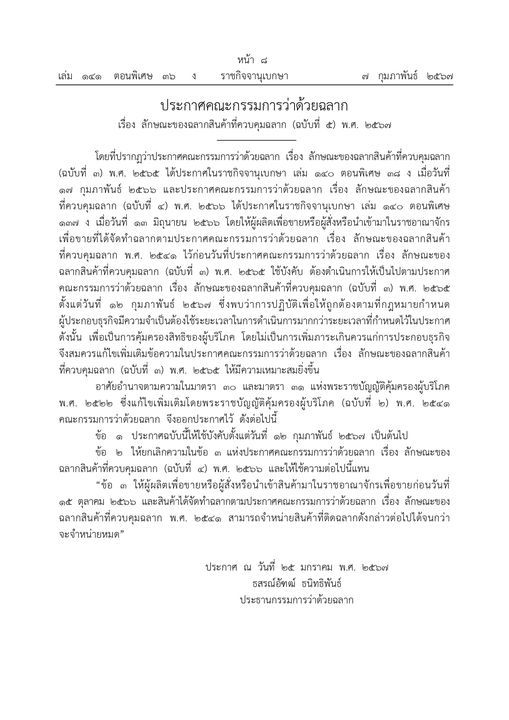Exciting news from the Committee on Labeling! They’ve unveiled the latest Characteristics of Controlled Labels (No. 5), a game-changer for businesses and consumers. Starting Feb 12, 2024, businesses must meet these new standards to ensure transparency and reliability in product labeling. This update is a win-win, empowering consumers with more information and fostering trust in the products they buy. Stay tuned for educational resources and workshops to guide everyone through this transition towards a more informed marketplace. #ConsumerProtection #LabelingStandards #CommitteeOnLabeling 🏷️🔍🛍️
The Committee on Labeling stands as an integral part of consumer protection, established under the robust framework of Thailand’s Consumer Protection Act. This entity functions to oversee and regulate the various aspects of product labeling, ensuring transparency and reliability for the end-users – the consumers. The committee is not just a regulatory body; it’s a bridge between legal mandates and public comprehension.
The Consumer Protection Act: A Closer Look
Incepted in the year 1979, the Consumer Protection Act, B.E. 2522, laid the groundwork for a series of consumer rights and protections. This act aimed to place a safeguard around the interests of consumers, regulating businesses and ensuring that the balance of fair trade is maintained. Over the years, the act has seen amendments that reflect the evolving market trends and consumer needs.
Latest Update from the Committee
In line with its ongoing efforts, the Committee on Labeling has recently rolled out a pivotal announcement. This latest directive brings to the fore the updated Characteristics of Controlled Labels, marked as the fifth revision in this domain. The significance of this update cannot be overstated, as it underscores the committee’s dedication to adapting and refining consumer protection standards.
Implications for Businesses
From February 12, 2024, businesses must adhere to the new standards set by the Characteristics of Controlled Labels (No. 5). Compliance with these guidelines is not optional; it’s a legal requirement. It implies that the packaging, labeling, and presentation of products will need to meet these freshly outlined criteria, ensuring that consumers are well-informed about the goods they purchase.
Impact on Consumers
For consumers, this amendment is a milestone in their right to information. The enhanced labeling characteristics are designed to provide greater clarity on product specifications, risks, and usage instructions. It is an empowering move that allows consumers to make more informed choices, fostering trust and confidence in the products they use daily.
What’s Next?
While the announcement has been made, the actual implementation is the next significant phase. Both businesses and consumers must familiarize themselves with the new labeling requirements. Educational campaigns, workshops, and resource materials are likely to be part of this transition period, as the Committee on Labeling works to align all stakeholders with the upcoming changes.
In essence, this update from the Committee on Labeling is more than just a regulatory tweak; it’s a step towards a more informed and protected consumer base, which is the cornerstone of any thriving marketplace. Businesses and consumers alike are encouraged to stay abreast of these developments to ensure a seamless transition to the new labeling standards.
Frequently Asked Questions
What are the new labeling standards introduced by the Committee on Labeling and when will they take effect?
The Committee on Labeling has introduced the latest Characteristics of Controlled Labels (No. 5), a set of new standards that businesses must adhere to starting February 12, 2024. These standards are designed to ensure transparency and reliability in product labeling, thereby enhancing consumer protection and fostering trust in the marketplace.
How does the Consumer Protection Act relate to the work of the Committee on Labeling?
The Consumer Protection Act, B.E. 2522, established in 1979, forms the foundation upon which the Committee on Labeling operates. This act provides a series of consumer rights and protections, with the Committee on Labeling functioning as an overseeing and regulatory body to ensure that the act’s objectives of consumer protection and fair trade are met. The committee serves as a conduit between legal mandates and public understanding, implementing regulation in the field of product labeling.
What can businesses and consumers expect in preparation for the transition to the new labeling standards?
In preparation for the transition to the new labeling standards, businesses and consumers can expect a range of educational campaigns, workshops, and resource materials to be provided by the Committee on Labeling. These resources are aimed at guiding stakeholders through the changes and ensuring that they are well-informed about the new labeling requirements. The focus will be on aligning all parties with the updated Characteristics of Controlled Labels for a seamless implementation when the changes become legally effective on February 12, 2024.




